



生物多样性 ›› 2025, Vol. 33 ›› Issue (6): 24290. DOI: 10.17520/biods.2024290 cstr: 32101.14.biods.2024290
• 研究报告: 动物多样性 • 下一篇
潘正东1( ), 林熙戎2(
), 林熙戎2( ), 薛华1(
), 薛华1( ), 胡治颖1(
), 胡治颖1( ), 郭弘艺1,3(
), 郭弘艺1,3( ), 张亚1,3(
), 张亚1,3( ), 吴阿娜2,*(
), 吴阿娜2,*( )(
)( ), 唐文乔1,3,*(
), 唐文乔1,3,*( )(
)( )
)
收稿日期:2024-07-02
接受日期:2024-10-16
出版日期:2025-06-20
发布日期:2025-03-20
通讯作者:
吴阿娜,唐文乔
基金资助:
Zhengdong Pan1( ), Xirong Lin2(
), Xirong Lin2( ), Hua Xue1(
), Hua Xue1( ), Zhiying Hu1(
), Zhiying Hu1( ), Hongyi Guo1,3(
), Hongyi Guo1,3( ), Ya Zhang1,3(
), Ya Zhang1,3( ), Enuo Wu2,*(
), Enuo Wu2,*( )(
)( ), Wenqiao Tang1,3,*(
), Wenqiao Tang1,3,*( )(
)( )
)
Received:2024-07-02
Accepted:2024-10-16
Online:2025-06-20
Published:2025-03-20
Contact:
Enuo Wu, Wenqiao Tang
Supported by:摘要:
为了解上海主要内陆水体鱼类多样性本底及其群落结构组成, 本文于2023年7-8月(夏季)和2023年10-11月(秋季)采集了上海13条河流和1个水库的鱼类, 共获标本20,160尾。经鉴定有16目24科54属71种, 其中鲤形目、虾虎鱼目和鲇形目分别占总种数的57.74%、9.86%和5.63%; 有淡水鱼类57种、河口鱼类11种、洄游鱼类3种; 其中的5种为外来种或人工培育种。这种鲈形系占比较高的分类学组成以及河口鱼类较丰富的生态类型, 代表了中国东部地区河口感潮河网鱼类组成的特点。14个水体平均有鱼类35.9种, 最多的浦南运河和浦东运河各有47种, 最少的滴水湖仅24种。本研究共发现15个优势种和14个常见种, 每个水体平均有优势种5种、常见种10种, 其中鲫(Carassius auratus)、大鳍鱊(Acheilognathus macropterus)、达氏鲌(Chanodichthys dabryi)和红鳍鲌(C. erythropterus)是14个水体总体的优势种。Margalef丰富度指数(D)、Shannon多样性指数(H′)、Pielou均匀度指数(J′)和Simpson优势度指数(C)均显示, 圆泄泾等13条河流的鱼类多样性水平较高, 滴水湖最低。各水体之间的Cody指数(βc)在4.0-15.5之间, 平均9.9; Routledge指数(βR)在12.44-28.76之间, 平均19.8, 表现出较大的物种差异性。丰度生物量曲线(abundance biomass comparison curve, ABC曲线)显示, 多数水体的统计量W为负值, 丰度优势度曲线大多在生物量曲线之上, 呈现出以中小型或小个体鱼类为主的群落结构特点。聚类分析可将14个水体的鱼类群落划分为4组, 除组I外的组内相似性均在74%左右, 组间相异性在31.42%-49.65%之间, 相异率贡献最高的为鲫、麦穗鱼(Pseudorasbora parva)和蒙古鲌(Chanodichthys mongolicus)。分析显示, 造成上海内陆水体鱼类群落结构这种差异的原因, 主要在于水体本身的自然条件、区域位置和放流活动。在保护好水域环境和鱼类栖息生境的前提下, 建筑物密集的大都市水域也能维持较高的鱼类物种多样性。
潘正东, 林熙戎, 薛华, 胡治颖, 郭弘艺, 张亚, 吴阿娜, 唐文乔 (2025) 上海主要内陆水体鱼类物种多样性本底及群落结构. 生物多样性, 33, 24290. DOI: 10.17520/biods.2024290.
Zhengdong Pan, Xirong Lin, Hua Xue, Zhiying Hu, Hongyi Guo, Ya Zhang, Enuo Wu, Wenqiao Tang (2025) Fish species diversity background and community structure in the main inland water bodies of Shanghai. Biodiversity Science, 33, 24290. DOI: 10.17520/biods.2024290.

图1 上海主要内陆水体采样点示意图。西大盈港: X1; 油墩港: Y1-Y3; 华田泾: H1; 蕰藻浜: W1-W5; 练祁河: L1-L3; 太浦河: T1-T2; 大蒸港: D1-D2; 圆泄泾: YX1; 掘石港: J1; 胥浦塘: XP1; 南竹港: N1-N2; 浦南运河: PN1-P4; 浦东运河: PD1-PD4; 滴水湖: DS1。
Fig. 1 Sampling site diagram in the main inland water bodies of Shanghai. Xidaying River: X1; Youdun River: Y1-Y3; Huatian River: H1; Wenzao River: W1-W5; Lianqi River: L1-L3; Taipu River: T1-T2; Dazheng River: D1-D2; Yuanxie River: YX1; Jueshi River: J1; Xupu River: XP1; Nanzhu River: N1-N2; Punan Canal: PN1-P4; Pudong Canal: PD1-PD4; Dishui Lake: DS1。
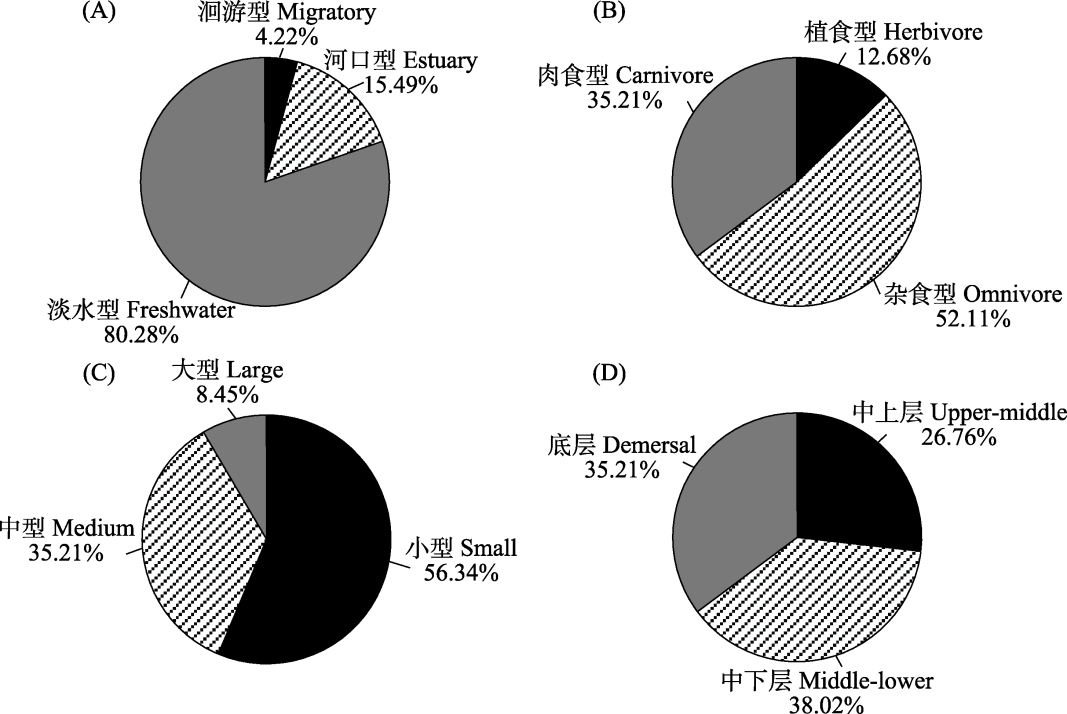
图2 上海内陆主要水体鱼类生态类群。(A)生活习性; (B)食性; (C)体型; (D)栖息水层。
Fig. 2 Fish ecological groups in the main inland water bodies of Shanghai. (A) Life habits; (B) Feeding habits; (C) Body type; (D) Habit characteristics.
| 种类 Species | IRI |
|---|---|
| 鲫 Carassius auratus | 2,554.3 |
| 大鳍鱊 Acheilognathus macropterus | 1,354.5 |
| 达氏鲌 Chanodichthys dabryi | 1,292.6 |
| 红鳍鲌 Chanodichthys erythropterus | 1,139.1 |
| 䱗 Hemiculter leucisculus | 854.2 |
| 兴凯鱊 Acheilognathus chankaensis | 853.8 |
| 翘嘴鲌 Culter alburnus | 756.8 |
| 麦穗鱼 Pseudorasbora parva | 678.9 |
| 似鳊 Pseudobrama simoni | 668.0 |
| 鲤 Cyprinus carpio | 597.0 |
| 蒙古鲌 Chanodichthys mongolicus | 491.9 |
| 鳙 Hypophthalmichthys nobilis | 333.2 |
| 高体鳑鲏 Rhodeus ocellatus | 328.4 |
| 河川沙塘鳢 Odontobutis potamophila | 320.9 |
| 鳊 Parabramis pekinensis | 318.6 |
| 鲢 Hypophthalmichthys molitrix | 309.8 |
| 棒花鱼 Abbottina rivularis | 281.0 |
| 刀鲚 Coilia ectenes | 203.8 |
| 似鱎 Toxabramis swinhonis | 171.7 |
| 乌鳢 Channa argus | 146.8 |
| 真吻虾虎鱼 Rhinogobius similis | 116.6 |
| 黑鳍鳈 Sarcocheilichthys nigripinnis | 103.4 |
| 大鳞副泥鳅 Misgurnus dabryanus | 100.0 |
表1 上海主要内陆水体鱼类总体的优势种和常见种
Table 1 Overall dominant species and common species of all fish in the main inland water bodies of Shanghai
| 种类 Species | IRI |
|---|---|
| 鲫 Carassius auratus | 2,554.3 |
| 大鳍鱊 Acheilognathus macropterus | 1,354.5 |
| 达氏鲌 Chanodichthys dabryi | 1,292.6 |
| 红鳍鲌 Chanodichthys erythropterus | 1,139.1 |
| 䱗 Hemiculter leucisculus | 854.2 |
| 兴凯鱊 Acheilognathus chankaensis | 853.8 |
| 翘嘴鲌 Culter alburnus | 756.8 |
| 麦穗鱼 Pseudorasbora parva | 678.9 |
| 似鳊 Pseudobrama simoni | 668.0 |
| 鲤 Cyprinus carpio | 597.0 |
| 蒙古鲌 Chanodichthys mongolicus | 491.9 |
| 鳙 Hypophthalmichthys nobilis | 333.2 |
| 高体鳑鲏 Rhodeus ocellatus | 328.4 |
| 河川沙塘鳢 Odontobutis potamophila | 320.9 |
| 鳊 Parabramis pekinensis | 318.6 |
| 鲢 Hypophthalmichthys molitrix | 309.8 |
| 棒花鱼 Abbottina rivularis | 281.0 |
| 刀鲚 Coilia ectenes | 203.8 |
| 似鱎 Toxabramis swinhonis | 171.7 |
| 乌鳢 Channa argus | 146.8 |
| 真吻虾虎鱼 Rhinogobius similis | 116.6 |
| 黑鳍鳈 Sarcocheilichthys nigripinnis | 103.4 |
| 大鳞副泥鳅 Misgurnus dabryanus | 100.0 |
| 河流 River | 物种数 Number of species | Margalef丰富度指数Margalef richness index (D) | Shannon多样性指数Shannon diversity index (H') | Pielou均匀度指数 Pielou evenness index (J°) | Simpson优势度指数Simpson dominance index (C) |
|---|---|---|---|---|---|
| 西大盈港 Xidaying River | 33 | 4.69 | 2.59 | 0.79 | 0.11 |
| 油墩港 Youdun River | 40 | 5.74 | 2.83 | 0.78 | 0.08 |
| 华田泾 Huatian River | 35 | 4.68 | 2.80 | 0.86 | 0.08 |
| 蕰藻浜 Wenzao River | 39 | 5.49 | 2.74 | 0.76 | 0.11 |
| 练祁河 Lianqi River | 37 | 5.66 | 3.01 | 0.83 | 0.06 |
| 太浦河 Taipu River | 39 | 5.36 | 2.83 | 0.81 | 0.09 |
| 大蒸港 Dazheng River | 30 | 4.51 | 2.65 | 0.80 | 0.10 |
| 圆泄泾 Yuanxie River | 35 | 5.87 | 3.03 | 0.86 | 0.07 |
| 掘石港 Jueshi River | 35 | 5.48 | 2.93 | 0.85 | 0.07 |
| 胥浦塘 Xupu River | 32 | 5.30 | 2.96 | 0.88 | 0.06 |
| 南竹港 Nanzhu River | 30 | 4.05 | 2.86 | 0.88 | 0.07 |
| 浦南运河 Punan Canal | 47 | 5.55 | 2.89 | 0.78 | 0.08 |
| 浦东运河 Pudong Canal | 47 | 5.51 | 2.75 | 0.74 | 0.09 |
| 滴水湖 Dishui Lake | 24 | 3.89 | 2.04 | 0.64 | 0.21 |
表2 上海内陆主要水体鱼类多样性指数的空间分布
Table 2 Spatial distribution of fish diversity index of main inland water bodies in Shanghai
| 河流 River | 物种数 Number of species | Margalef丰富度指数Margalef richness index (D) | Shannon多样性指数Shannon diversity index (H') | Pielou均匀度指数 Pielou evenness index (J°) | Simpson优势度指数Simpson dominance index (C) |
|---|---|---|---|---|---|
| 西大盈港 Xidaying River | 33 | 4.69 | 2.59 | 0.79 | 0.11 |
| 油墩港 Youdun River | 40 | 5.74 | 2.83 | 0.78 | 0.08 |
| 华田泾 Huatian River | 35 | 4.68 | 2.80 | 0.86 | 0.08 |
| 蕰藻浜 Wenzao River | 39 | 5.49 | 2.74 | 0.76 | 0.11 |
| 练祁河 Lianqi River | 37 | 5.66 | 3.01 | 0.83 | 0.06 |
| 太浦河 Taipu River | 39 | 5.36 | 2.83 | 0.81 | 0.09 |
| 大蒸港 Dazheng River | 30 | 4.51 | 2.65 | 0.80 | 0.10 |
| 圆泄泾 Yuanxie River | 35 | 5.87 | 3.03 | 0.86 | 0.07 |
| 掘石港 Jueshi River | 35 | 5.48 | 2.93 | 0.85 | 0.07 |
| 胥浦塘 Xupu River | 32 | 5.30 | 2.96 | 0.88 | 0.06 |
| 南竹港 Nanzhu River | 30 | 4.05 | 2.86 | 0.88 | 0.07 |
| 浦南运河 Punan Canal | 47 | 5.55 | 2.89 | 0.78 | 0.08 |
| 浦东运河 Pudong Canal | 47 | 5.51 | 2.75 | 0.74 | 0.09 |
| 滴水湖 Dishui Lake | 24 | 3.89 | 2.04 | 0.64 | 0.21 |
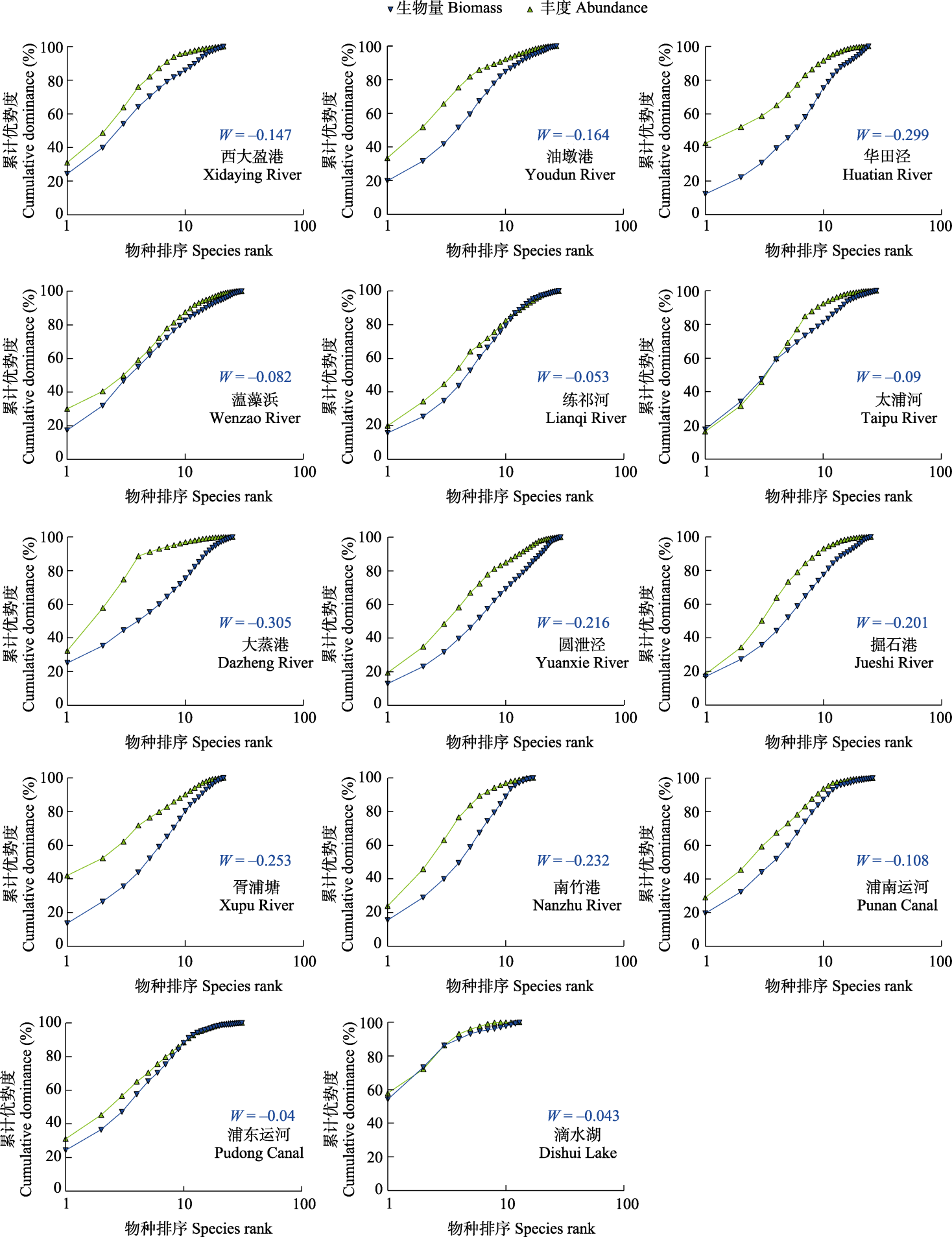
图3 上海主要内陆水体夏季鱼类群落的丰度生物量(ABC)曲线及其统计量(W)
Fig. 3 Abundance biomass comparison (ABC) curves and their statistics (W) for fish communities in the main inland water bodies of Shanghai in summer
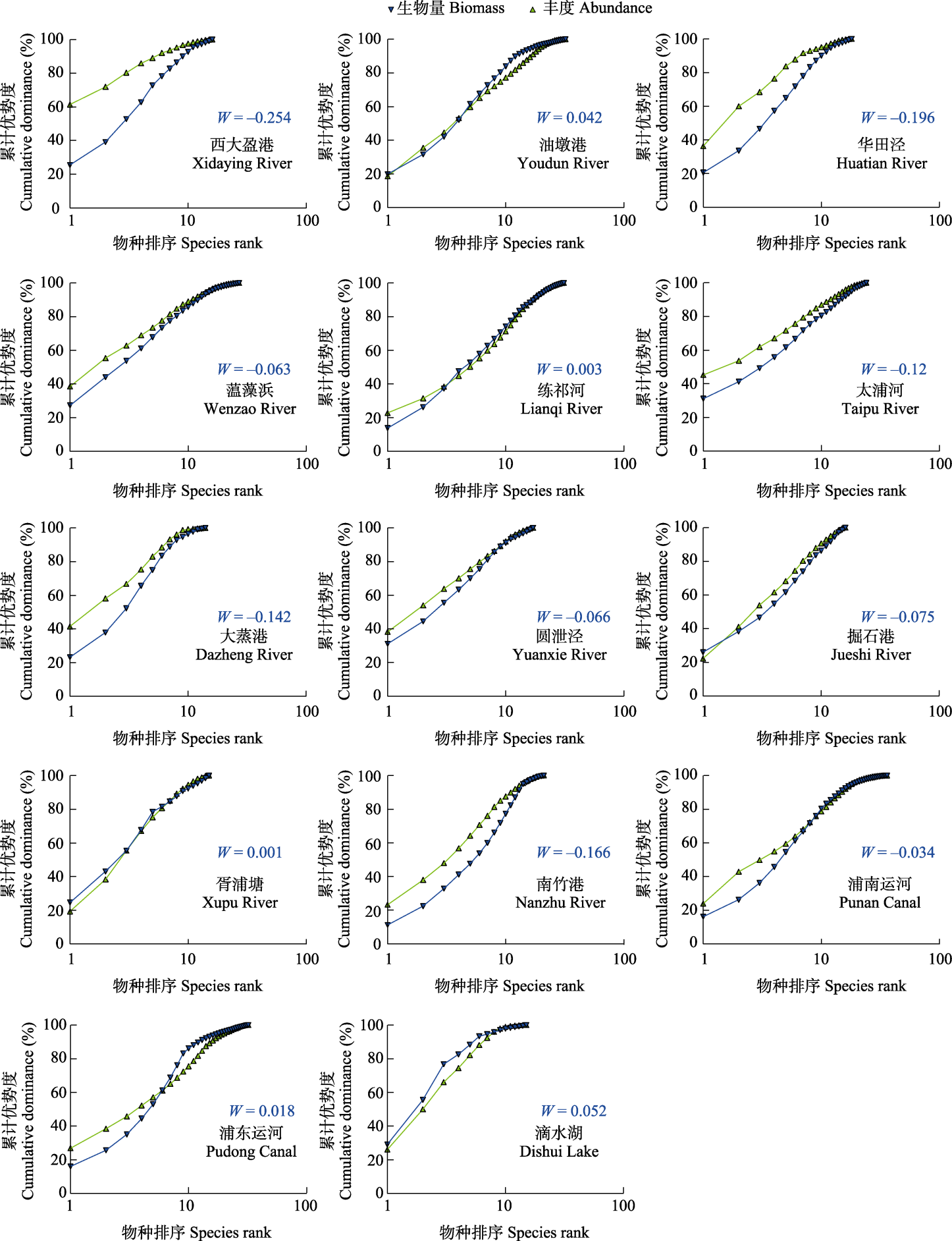
图4 上海主要内陆水体秋季鱼类群落的丰度生物量(ABC)曲线及其统计量(W)
Fig. 4 Abundance biomass comparison (ABC) curves and their statistics (W) for fish communities in the main inland water bodies of Shanghai in autumn
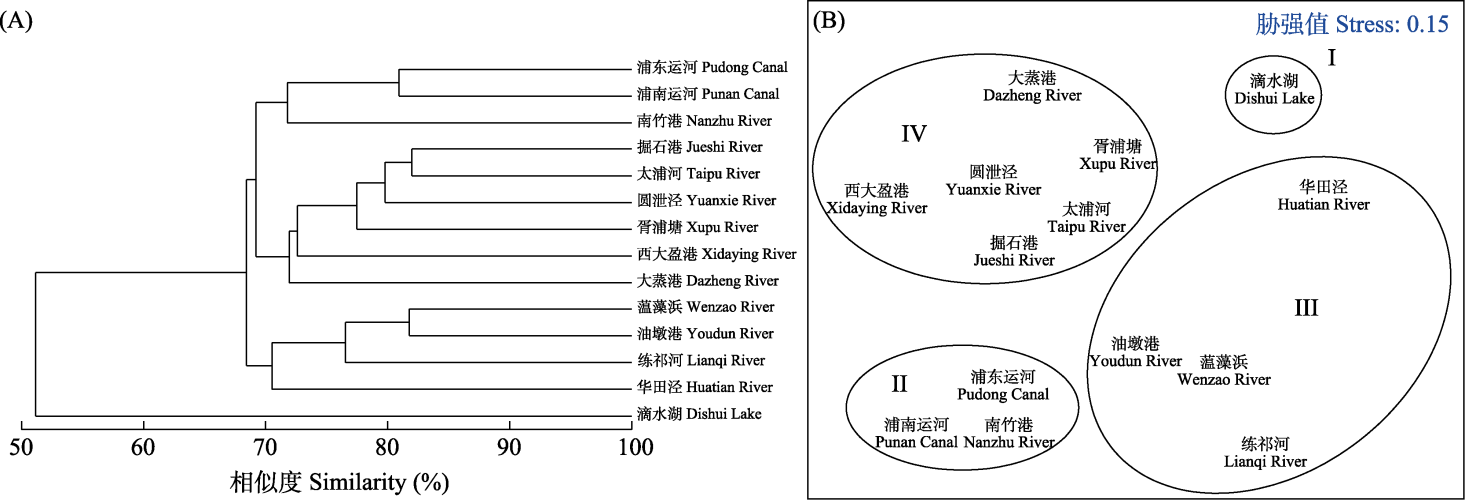
图5 上海主要内陆水体鱼类群落聚类图(A)和非度量多维标度排序(NMDS)图(B)
Fig. 5 Cluster map (A) and non-metric multidimensional scaling (NMDS) map (B) of fish communities in the main inland water bodies of Shanghai
| 群组 Group | 平均相似性 Average similarity (%) | 平均相异性 Average dissimilarity (%) | |||||||||||||||||
|---|---|---|---|---|---|---|---|---|---|---|---|---|---|---|---|---|---|---|---|
| II | III | IV | I-II | I-III | I-IV | II-III | II-IV | III-IV | |||||||||||
| 鲫 Carassius auratus | 6.42 | 6.32 | 6.88 | 5.97 | 5.76 | 6.46 | |||||||||||||
| 大鳍鱊 Acheilognathus macropterus | 6.21 | 5.48 | 5.84 | 2.40 | 2.67 | ||||||||||||||
| 兴凯鱊 Acheilognathus chankaensis | 5.66 | 5.77 | 4.71 | 2.93 | 2.59 | ||||||||||||||
| 无须鱊 Acheilognathus gracilis | 4.37 | 3.34 | 4.10 | 4.30 | 5.35 | ||||||||||||||
| 斜方鱊 Acheilognathus rhombeus | 2.47 | 2.84 | 3.16 | ||||||||||||||||
| 中华鳑鲏 Rhodeus sinensis | 2.44 | 3.33 | 2.81 | ||||||||||||||||
| 高体鳑鲏 Rhodeus ocellatus | 5.72 | 4.25 | 3.70 | 5.31 | 4.31 | 2.27 | |||||||||||||
| 方氏鳑鲏 Rhodeus fangi | 2.81 | 2.99 | |||||||||||||||||
| 鲤 Cyprinus carpio | 2.55 | 3.71 | 2.27 | ||||||||||||||||
| 䱗 Hemiculter leucisculus | 5.58 | 5.10 | 4.95 | ||||||||||||||||
| 贝氏䱗 Hemiculter bleekeri | 2.51 | 3.05 | |||||||||||||||||
| 鲢 Hypophthalmichthys molitrix | 2.38 | ||||||||||||||||||
| 鳙 Hypophthalmichthys nobilis | 3.25 | 2.59 | |||||||||||||||||
| 花䱻 Hemibarbus maculatus | 4.67 | 3.27 | 4.43 | ||||||||||||||||
| 麦穗鱼 Pseudorasbora parva | 5.24 | 5.13 | 5.21 | 5.21 | 4.83 | 5.14 | |||||||||||||
| 棒花鱼 Abbottina rivularis | 5.20 | 3.50 | 2.33 | ||||||||||||||||
| 蛇鮈 Saurogobio dabryi | 3.36 | 3.62 | 4.09 | ||||||||||||||||
| 翘嘴鲌 Culter alburnus | 4.18 | ||||||||||||||||||
| 达氏鲌 Chanodichthys dabryi | 4.55 | 5.56 | 5.75 | ||||||||||||||||
| 蒙古鲌 Chanodichthys mongolicus | 3.41 | 3.76 | 3.13 | 2.36 | 2.37 | ||||||||||||||
| 红鳍鲌 Chanodichthys erythropterus | 5.47 | 4.71 | 5.57 | 2.45 | |||||||||||||||
| 鳊 Parabramis pekinensis | 2.62 | 2.62 | 3.24 | 2.47 | |||||||||||||||
| 似鳊 Pseudobrama simoni | 4.47 | 3.34 | |||||||||||||||||
| 刀鲚 Coilia ectenes | 4.06 | 2.04 | 2.69 | 2.51 | |||||||||||||||
| 华鳈 Sarcocheilichthys sinensis | 3.30 | 2.00 | 2.19 | 3.43 | |||||||||||||||
| 小黄黝鱼 Micropercops swinhonis | 3.16 | 1.99 | 4.32 | 2.28 | |||||||||||||||
| 河川沙塘鳢 Odontobutis potamophila | 4.77 | 4.62 | 3.73 | 3.94 | |||||||||||||||
| 乌鳢 Channa argus | 2.80 | 3.44 | 2.27 | 2.34 | |||||||||||||||
| 泥鳅 Misgurnus anguillicaudatus | 2.59 | 2.66 | 2.06 | ||||||||||||||||
| 大鳞副泥鳅 Misgurnus dabryanus | 3.74 | 2.59 | 2.89 | ||||||||||||||||
| 光泽黄颡鱼 Tachysurus nitidus | 2.94 | 2.66 | |||||||||||||||||
| 鲇 Silurus asotus | 2.38 | 2.01 | |||||||||||||||||
| 似鱎 Toxabramis swinhonis | 2.86 | 2.18 | 2.27 | ||||||||||||||||
| 中国花鲈 Lateolabrax maculatus | 2.12 | 2.04 | |||||||||||||||||
| 真吻虾虎鱼 Rhinogobius similis | 4.25 | 2.57 | 2.56 | ||||||||||||||||
| 双带缟虾虎鱼 Tridentiger bifasciatus | 2.66 | 3.10 | 2.75 | 2.79 | |||||||||||||||
| 拉氏狼牙虾虎鱼 Odontamblyopus lacepedii | 2.74 | 1.90 | 3.18 | 2.39 | |||||||||||||||
| 血鹦鹉鱼(Vieja synsplia ♀ × Amphilophus citrinellus ♂) | 2.24 | ||||||||||||||||||
| 鲻 Mugil cephalus | 1.85 | ||||||||||||||||||
| 中华刺鳅 Sinobdella sinensis | 2.04 | ||||||||||||||||||
表3 各分组平均相似性(相异性)贡献率之和占50%以上的特征种和分歧种。I, II, III, IV表示14个水体的鱼类群落聚类为4组。
Table 3 The special species and divergent species with more than 50% of the sum of the average similarity (dissimilarity) contribution rate of each group. I, II, III, IV denote fish communities clustered into 4 groups for 14 water bodies.
| 群组 Group | 平均相似性 Average similarity (%) | 平均相异性 Average dissimilarity (%) | |||||||||||||||||
|---|---|---|---|---|---|---|---|---|---|---|---|---|---|---|---|---|---|---|---|
| II | III | IV | I-II | I-III | I-IV | II-III | II-IV | III-IV | |||||||||||
| 鲫 Carassius auratus | 6.42 | 6.32 | 6.88 | 5.97 | 5.76 | 6.46 | |||||||||||||
| 大鳍鱊 Acheilognathus macropterus | 6.21 | 5.48 | 5.84 | 2.40 | 2.67 | ||||||||||||||
| 兴凯鱊 Acheilognathus chankaensis | 5.66 | 5.77 | 4.71 | 2.93 | 2.59 | ||||||||||||||
| 无须鱊 Acheilognathus gracilis | 4.37 | 3.34 | 4.10 | 4.30 | 5.35 | ||||||||||||||
| 斜方鱊 Acheilognathus rhombeus | 2.47 | 2.84 | 3.16 | ||||||||||||||||
| 中华鳑鲏 Rhodeus sinensis | 2.44 | 3.33 | 2.81 | ||||||||||||||||
| 高体鳑鲏 Rhodeus ocellatus | 5.72 | 4.25 | 3.70 | 5.31 | 4.31 | 2.27 | |||||||||||||
| 方氏鳑鲏 Rhodeus fangi | 2.81 | 2.99 | |||||||||||||||||
| 鲤 Cyprinus carpio | 2.55 | 3.71 | 2.27 | ||||||||||||||||
| 䱗 Hemiculter leucisculus | 5.58 | 5.10 | 4.95 | ||||||||||||||||
| 贝氏䱗 Hemiculter bleekeri | 2.51 | 3.05 | |||||||||||||||||
| 鲢 Hypophthalmichthys molitrix | 2.38 | ||||||||||||||||||
| 鳙 Hypophthalmichthys nobilis | 3.25 | 2.59 | |||||||||||||||||
| 花䱻 Hemibarbus maculatus | 4.67 | 3.27 | 4.43 | ||||||||||||||||
| 麦穗鱼 Pseudorasbora parva | 5.24 | 5.13 | 5.21 | 5.21 | 4.83 | 5.14 | |||||||||||||
| 棒花鱼 Abbottina rivularis | 5.20 | 3.50 | 2.33 | ||||||||||||||||
| 蛇鮈 Saurogobio dabryi | 3.36 | 3.62 | 4.09 | ||||||||||||||||
| 翘嘴鲌 Culter alburnus | 4.18 | ||||||||||||||||||
| 达氏鲌 Chanodichthys dabryi | 4.55 | 5.56 | 5.75 | ||||||||||||||||
| 蒙古鲌 Chanodichthys mongolicus | 3.41 | 3.76 | 3.13 | 2.36 | 2.37 | ||||||||||||||
| 红鳍鲌 Chanodichthys erythropterus | 5.47 | 4.71 | 5.57 | 2.45 | |||||||||||||||
| 鳊 Parabramis pekinensis | 2.62 | 2.62 | 3.24 | 2.47 | |||||||||||||||
| 似鳊 Pseudobrama simoni | 4.47 | 3.34 | |||||||||||||||||
| 刀鲚 Coilia ectenes | 4.06 | 2.04 | 2.69 | 2.51 | |||||||||||||||
| 华鳈 Sarcocheilichthys sinensis | 3.30 | 2.00 | 2.19 | 3.43 | |||||||||||||||
| 小黄黝鱼 Micropercops swinhonis | 3.16 | 1.99 | 4.32 | 2.28 | |||||||||||||||
| 河川沙塘鳢 Odontobutis potamophila | 4.77 | 4.62 | 3.73 | 3.94 | |||||||||||||||
| 乌鳢 Channa argus | 2.80 | 3.44 | 2.27 | 2.34 | |||||||||||||||
| 泥鳅 Misgurnus anguillicaudatus | 2.59 | 2.66 | 2.06 | ||||||||||||||||
| 大鳞副泥鳅 Misgurnus dabryanus | 3.74 | 2.59 | 2.89 | ||||||||||||||||
| 光泽黄颡鱼 Tachysurus nitidus | 2.94 | 2.66 | |||||||||||||||||
| 鲇 Silurus asotus | 2.38 | 2.01 | |||||||||||||||||
| 似鱎 Toxabramis swinhonis | 2.86 | 2.18 | 2.27 | ||||||||||||||||
| 中国花鲈 Lateolabrax maculatus | 2.12 | 2.04 | |||||||||||||||||
| 真吻虾虎鱼 Rhinogobius similis | 4.25 | 2.57 | 2.56 | ||||||||||||||||
| 双带缟虾虎鱼 Tridentiger bifasciatus | 2.66 | 3.10 | 2.75 | 2.79 | |||||||||||||||
| 拉氏狼牙虾虎鱼 Odontamblyopus lacepedii | 2.74 | 1.90 | 3.18 | 2.39 | |||||||||||||||
| 血鹦鹉鱼(Vieja synsplia ♀ × Amphilophus citrinellus ♂) | 2.24 | ||||||||||||||||||
| 鲻 Mugil cephalus | 1.85 | ||||||||||||||||||
| 中华刺鳅 Sinobdella sinensis | 2.04 | ||||||||||||||||||
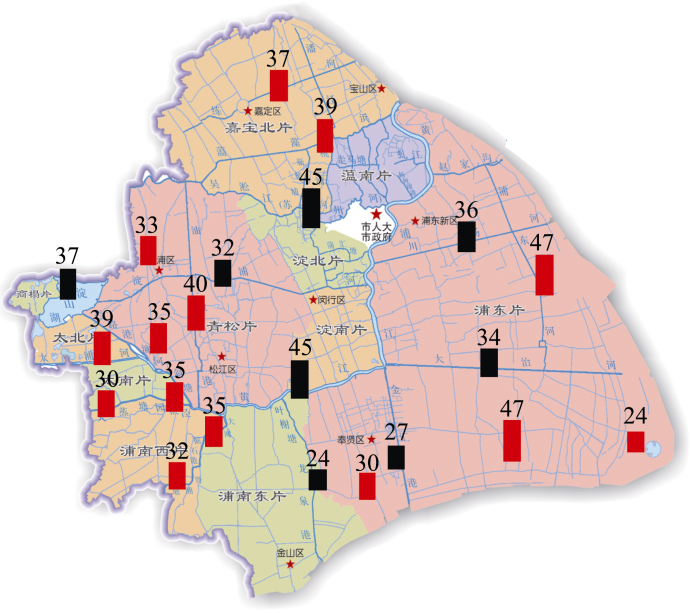
图6 上海22个水体的鱼类物种数目。红色柱子为本文数据, 黑色柱子为本研究团队近期获得的数据(余宏昌等, 2021; 邵严等, 2022; 陈振锋等, 2023)。
Fig. 6 Number of fish species in Shanghai inland river in 22 water bodies. Red columns represent the data in this paper, black columns represent data recently obtained by our research team (Yu et al, 2021; Shao et al, 2022; Chen et al, 2023).
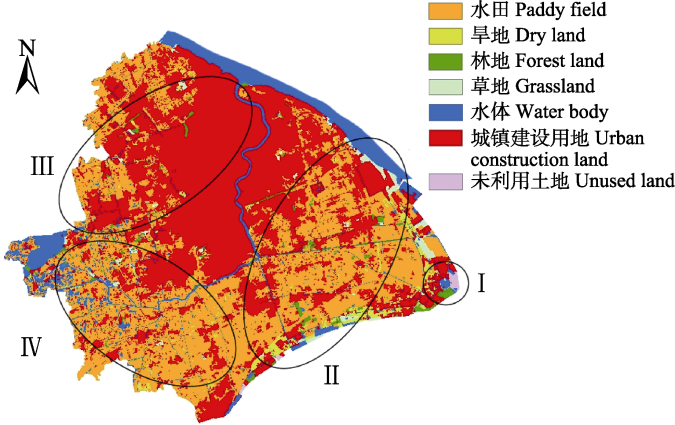
图7 上海主要内陆水体鱼类群落结构与土地利用(徐新良等, 2023)的相关性
Fig. 7 Relationship between fish community structure and land use in the main water bodies of Shanghai (Xu et al, 2023)
| [1] |
Chen XH, Li XP, Cheng X (2008) Spatial-temporal distribution of fish assemblages in the upstreams of Huangpu River and Suzhou Creek. Biodiversity Science, 16, 191-196. (in Chinese with English abstract)
DOI |
|
[陈小华, 李小平, 程曦 (2008) 黄浦江和苏州河上游鱼类多样性组成的时空特征. 生物多样性, 16, 191-196.]
DOI |
|
| [2] | Chen YY (1998) Fauna Sinica:Osteichthyes·Cypriniformes (II). Science Press, Beijing. (in Chinese) |
| [陈宜瑜 (1998) 中国动物志: 硬骨鱼纲·鲤形目(中卷). 科学出版社, 北京.] | |
| [3] | Chen ZF, Tang WQ, Zhao ZG, Zhang YY, Gong L, Tang Z, Zhang Y, Guo HY, Liu D, Yang JQ (2023) Fish background investigation and community structure analysis of five backbone artificial rivers in Shanghai. Acta Hydrobiologica Sinica, 47, 399-411. (in Chinese with English abstract) |
| [陈振锋, 唐文乔, 赵振官, 张彦彦, 龚珑, 唐振, 张亚, 郭弘艺, 刘东, 杨金权 (2023) 上海5条骨干人工河流鱼类本底调查及群落结构分析. 水生生物学报, 47, 399-411.] | |
| [4] | Cheng QT, Zheng BS (1987) Systematic Synopsis of Chinese Fishes. Science Press, Beijing. (in Chinese) |
| [成庆泰, 郑葆珊 (1987) 中国鱼类系统检索, 科学出版社, 北京.] | |
| [5] | Clarke KR, Warwick RM (2001) Change in the marine communities: An approach to statistical analysis and interpretation. Mount Sinai Journal of Medicine New York, 40, 689-692. |
| [6] | Dang YC, Dai XJ, Wu F (2021) Analysis of seasonal changes of fish community structure in Dianshan Lake. Fisheries Science, 40, 361-368. (in Chinese with English abstract) |
| [党莹超, 戴小杰, 吴峰 (2021) 淀山湖鱼类群落结构季节性变化分析. 水产科学, 40, 361-368.] | |
| [7] | Dong F, Fang DD, Zhang H, Wei QW (2023) Protection and development after the ten-year fishing ban in the Yangtze River. Journal of Fisheries of China, 47, 245-259. (in Chinese with English abstract) |
| [董芳, 方冬冬, 张辉, 危起伟 (2023) 长江十年禁渔后保护与发展. 水产学报, 47, 245-259.] | |
| [8] | East China Sea Fishery Research Institute, Chinese Academy of Fishery Sciences (1990) Fishes in Shanghai. Shanghai Scientific & Technical Publishers, Shanghai. (in Chinese) |
| [中国水产科学研究院东海水产研究所 (1990) 上海鱼类志. 上海科学技术出版社, 上海.] | |
| [9] |
Gao X, Zhao YH, Tian F, Wang XA, Li MZ, Lin PC, Chang T, Yu D, Liu HZ (2023) Progress of monitoring and research of China inland water fish biodiversity observation network. Biodiversity Science, 31, 23427. (in Chinese with English abstract)
DOI |
|
[高欣, 赵亚辉, 田菲, 王晓爱, 黎明政, 林鹏程, 常涛, 俞丹, 刘焕章 (2023) 中国内陆水体鱼类多样性监测专项网的监测和研究进展. 生物多样性, 31, 23427.]
DOI |
|
| [10] | Han C, Gao CX, Tian SQ, Dai XJ (2014) Interannual variation of fish community structure diversity in Dianshan Lake. Journal of Shanghai Ocean University, 23, 403-410. (in Chinese with English abstract) |
| [韩婵, 高春霞, 田思泉, 戴小杰 (2014) 淀山湖鱼类群落结构多样性的年际变化. 上海海洋大学学报, 23, 403-410.] | |
| [11] | Hong B, Wang M, Zhang YP, Sun ZZ (2013) Component and diversity of fishes in the fishery water of upper reaches of the Huangpu River. Journal of Anhui Agricultural Sciences, 41, 6737-6739. (in Chinese with English abstract) |
| [洪波, 王淼, 张玉平, 孙振中 (2013) 黄浦江上游渔业水域鱼类组成及多样性. 安徽农业科学, 41, 6737-6739.] | |
| [12] | Hu XF, Deng W (2022) 2022 Shanghai River (Lake) Report. (in Chinese) |
| [胡险峰, 邓武 (2022) 2022上海市河道(湖泊)报告.] https://swj.sh.gov.cn/hhbg/20230117/2a849d92b5bd4a69b8dda022b0ad061e.html. (accessed on 2023-12-25) | |
| [13] | Jin DL (2021) The study on the water pollution of Huangpu River system in Shanghai (1963-1976). Researches in Chinese Economic History, (1), 168-182. (in Chinese with English abstract) |
| [金大陆 (2021) 20世纪六七十年代上海黄浦江水系污染问题研究(1963-1976). 中国经济史研究, (1), 168-182.] | |
| [14] | Li YL, Li YF, Li K (2016) Relative influence of anthropogenic stressors on fish and macroinvertebrate communities at different scales in Huntai Rivers. Research of Environmental Sciences, 29, 1145-1153. (in Chinese with English abstract) |
| [李艳丽, 李艳粉, 李科 (2016) 不同尺度下人类活动对浑太河流域鱼类和大型底栖动物群落特征的影响. 环境科学研究, 29, 1145-1153.] | |
| [15] | Li YL, Liu QG, Chen LP, Zhao LJ, Wu H, Chen LQ, Hu ZJ (2018) A comparison between benthic gillnet and bottom trawl for assessing fish assemblages in a shallow eutrophic lake near the Changjiang River estuary. Chinese Journal of Oceanology and Limnology, 36, 572-586. |
| [16] | Ni Y, Wu HL (2006) Fishes in Jiangsu. China Agriculture Press, Beijing. (in Chinese) |
| [倪勇, 伍汉霖 (2006) 江苏鱼类志. 中国农业出版社, 北京.] | |
| [17] | Ni Y, Zhu CD (2005) Fishes of the Taihu Lake. Shanghai Scientific & Technical Publishers, Shanghai. (in Chinese) |
| [倪勇, 朱成德 (2005) 太湖鱼类志. 上海科学技术出版社, 上海.] | |
| [18] | Pinkas L, Oliphant MS, Iverson ILK (1971) Fish Bulletin 152. Food Habits of Albacore, Bluefin tuna, and Bonito in California Waters. https://escholarship.org/uc/item/7t5868rd. (accessed on 2024-01-20) |
| [19] | Qiu XY (1986) Countermeasures for water pollution control of Huangpu River. China Environmental Management, (5), 9-11. (in Chinese) |
| [裘鑫炎 (1986) 黄浦江水质污染治理对策. 中国环境管理, (5), 9-11.] | |
| [20] | Rass TS, Lindberg GU (1971) Modern Concepts of the Natural System of Recent Fishes. Nauka Publishing House, Moscow. |
| [21] | Routledge RD (1977) On Whittaker’s components of diversity. Ecology, 58, 1120-1127. |
| [22] | Shanghai Bureau of Statistics (2023) Shanghai Statistical Yearbook. China Statistics Press, Beijing. (in Chinese) |
| [上海统计局 (2023) 2023年上海统计年鉴. 中国统计出版社, 北京.] | |
| [23] | Shanghai Water Authority (2023) Plan for the Construction of Shanghai’s Water Network. (in Chinese) |
| [上海市水务局 (2023) 上海市水网建设规划.] https://swj.sh.gov.cn/ghjhua/20240223/b54f8d5a55f14134ac1d3596220bfebc.html. (accessed on 2024-02-23) | |
| [24] | Shao Y, Tang WQ, Gong L, Zhang Y, Guo HY (2022) Analysis of fish species diversity and assemblage of Dianshan Lake and upper reaches of Huangpu River in Shanghai. Resources and Environment in the Yangtze Basin, 31, 1482-1493. (in Chinese with English abstract) |
| [邵严, 唐文乔, 龚珑, 张亚, 郭弘艺 (2022) 上海淀山湖及黄浦江上游鱼类物种多样性及群落结构分析. 长江流域资源与环境, 31, 1482-1493.] | |
| [25] | Sun JY, Dai XJ, Zhu JF, Ji WB, Tian ZQ (2007) Analysis of the fish species diversity in Dianshan Lake. Journal of Shanghai Fisheries University, 16, 454-459. (in Chinese with English abstract) |
| [孙菁煜, 戴小杰, 朱江峰, 季伟彬, 田芝清 (2007) 淀山湖鱼类多样性分析. 上海水产大学学报, 16, 454-459.] | |
| [26] | Tang WQ, Zhu TJ, Chen JK, Han HF, Sun Y (2003) Resources and conservation valuation of fishes of Jiuduansha wetland in Changjiang River estuary. Journal of Shanghai Fisheries University, 12, 193-200. (in Chinese with English abstract) |
| [唐文乔, 诸廷俊, 陈家宽, 韩洪发, 孙瑛 (2003) 长江口九段沙湿地的鱼类资源及其保护价值. 上海水产大学学报, 12, 193-200.] | |
| [27] | Tao J, Dai XJ, Tian SQ, Ma C (2011) Community diversity and growth characteristics of wild fishes in Dianshan Lake. Hunan Agricultural Sciences, (7), 137-141. (in Chinese with English abstract) |
| [陶洁, 戴小杰, 田思泉, 马超 (2011) 淀山湖野生鱼类群落多样性与生长特性研究. 湖南农业科学, (7), 137-141.] | |
| [28] | Wang XD, Zhu H, Gu ZJ, Wu ZF, Zhu L, Shi X, Cheng GF, Che X, Liu XG (2014) Community composition and the relationship between measurable characters and total weight for the native fishes from upper rivers of Huangpu River area. Fishery Modernization, 41(3), 43-47. (in Chinese with English abstract) |
| [王小冬, 朱浩, 顾兆俊, 吴宗凡, 朱林, 时旭, 程果锋, 车轩, 刘兴国 (2014) 黄浦江上游水域土著鱼类组成及体重与可量性状关系研究. 渔业现代化, 41(3), 43-47.] | |
| [29] | Warwick RM, Pearson TH, Ruswahyuni (1987) Detection of pollution effects on marine macrobenthos: Further evaluation of the species abundance/biomass method. Marine Biology, 95, 193-200. |
| [30] | Wei B, Wang XD, Liu XG, Gu ZJ, Zeng XL (2019) Seasonal variation of fish composition and diversity in Yuanxiejing tributary of the upper reaches of Huangpu River. Southwest China Journal of Agriculture, 32, 1664-1669. (in Chinese with English abstract) |
| [魏布, 王小冬, 刘兴国, 顾兆俊, 曾宪磊 (2019) 黄浦江上游支流-圆泄泾鱼类组成及多样性季节变化. 西南农业学报, 32, 1664-1669.] | |
| [31] | Whittaker RH (1972) Evolution and measurement of species diversity. Taxon, 21, 213-251. |
| [32] | Wu EN, Che Y, Xu QX, Yang K (2007) Approach for health assessment of rivers in Shanghai. Journal of Ecology and Rural Environment, 23(4), 90-94. (in Chinese with English abstract) |
| [吴阿娜, 车越, 徐启新, 杨凯 (2007) 上海地区河流健康评价方法探讨. 生态与农村环境学报, 23(4), 90-94.] | |
| [33] | Xia JH, Lu JF, Zhou BC, Tan HZ (2009) A preliminary study on fish communities in Suzhou Creek, Shanghai. Journal of Lake Sciences, 21, 538-546. (in Chinese with English abstract) |
| [夏建宏, 陆剑锋, 周保春, 谈慧珍 (2009) 上海苏州河鱼类群落的初步研究. 湖泊科学, 21, 538-546.] | |
| [34] | Xia ZQ, Gu JN, Wen Y, Cao XK, Gao YC, Li SG, Haffner GD, MacIsaac HJ, Zhan AB (2024) eDNA-based detection reveals invasion risks of a biofouling bivalve in the world’s largest water diversion project. Ecological Applications, 34, e2826. |
| [35] | Xu XL, Liu JY, Zhang SW, Li RD, Yan CZ, Wu SX (2023) Remote sensing data set of multi-period land use monitoring in China (CNLUCC). Data Registration and Publishing System of Resource and Environmental Science Data Center of Chinese Academy of Science, doi:10.12078/2018070201. (in Chinese) |
| [徐新良, 刘纪远, 张树文, 李仁东, 颜长珍, 吴世新 (2023) 中国多时期土地利用遥感监测数据集(CNLUCC). 中国科学院资源环境科学数据注册与出版系统, doi:10.12078/2018070201.] | |
| [36] | Yu HC, Bi BS, Tang WQ, Zhang Y, Guo HY (2021) Changes in fish diversity and assemblage during comprehensive restoration of the Suzhou River in Shanghai. Biodiversity Science, 29, 32-42. (in Chinese with English abstract) |
| [余宏昌, 毕宝帅, 唐文乔, 张亚, 郭弘艺 (2021) 上海苏州河治理中鱼类多样性及群落结构变化. 生物多样性, 29, 32-42.] | |
| [37] | Zhang CG, Zhao YH (2016) Species Diversity and Distribution of Inland Fishes in China. Science Press, Beijing. (in Chinese) |
| [张春光, 赵亚辉 (2016) 中国内陆鱼类与分布. 科学出版社, 北京.] | |
| [38] | Zhang ZM, Yang Y, Ding HP, Chang XL, Liang YQ, Zhai ZY, Chen F (2023) Design of fish breeding and release schemes based on fish resource surveys: Case study of Zhadun Water Control Project. Journal of Hydroecology, 44, 41-48. (in Chinese with English abstract) |
| [张志明, 杨洋, 丁慧萍, 常秀岭, 梁银铨, 翟占英, 陈锋 (2023) 基于鱼类资源调查的增殖放流方案前期研究——以扎敦水利枢纽为例. 水生态学杂志, 44, 41-48.] | |
| [39] | Zhou TS, Zhang Y, Tang WQ, Wang LQ (2016) Ecological health assessment of Huangpu River based on fish index of biotic integrity. Resources and Environment in the Yangtze River Basin, 25, 895-903. (in Chinese with English abstract) |
| [周天舒, 张亚, 唐文乔, 王丽卿 (2016) 基于鱼类完整性指数的黄浦江水生态系统评价. 长江流域资源与环境, 25, 895-903.] |
| [1] | 黄骏涵, 余梵冬, 王裕祥, 黄哲, 张铭斯, 房苗, 舒璐, 徐猛, 韦慧, 汪学杰, 顾党恩, 罗思. 花地河中下游外来鱼类入侵现状及其与环境因子的关系[J]. 生物多样性, 2024, 32(11): 24249-. |
| [2] | 余宏昌, 毕宝帅, 唐文乔, 张亚, 郭弘艺. 上海苏州河治理中鱼类多样性及群落结构变化[J]. 生物多样性, 2021, 29(1): 32-42. |
| [3] | 余建平,王江月,肖慧芸,陈小南,陈声文,李晟,申小莉. 利用红外相机公里网格调查钱江源国家公园的兽类及鸟类多样性[J]. 生物多样性, 2019, 27(12): 1339-1344. |
| [4] | 钱海源,余建平,申小莉,丁平,李晟. 钱江源国家公园体制试点区鸟类多样性与区系组成[J]. 生物多样性, 2019, 27(1): 76-80. |
| [5] | 李渊, 张静, 张然, 宋普庆, 钟指挥, 王燕平, 林龙山. 南沙群岛西南部和北部湾口海域鱼类物种多样性[J]. 生物多样性, 2016, 24(2): 166-174. |
| [6] | 张春光, 赵亚辉, 邢迎春, 郭瑞禄, 张清, 冯云, 樊恩源. 北京及其邻近地区野生鱼类物种多样性及其资源保育[J]. 生物多样性, 2011, 19(5): 597-604. |
| [7] | 陈小华, 李小平, 程曦. 黄浦江和苏州河上游鱼类多样性组成的时空特征[J]. 生物多样性, 2008, 16(2): 191-196. |
| 阅读次数 | ||||||
|
全文 |
|
|||||
|
摘要 |
|
|||||
备案号:京ICP备16067583号-7
Copyright © 2022 版权所有 《生物多样性》编辑部
地址: 北京香山南辛村20号, 邮编:100093
电话: 010-62836137, 62836665 E-mail: biodiversity@ibcas.ac.cn